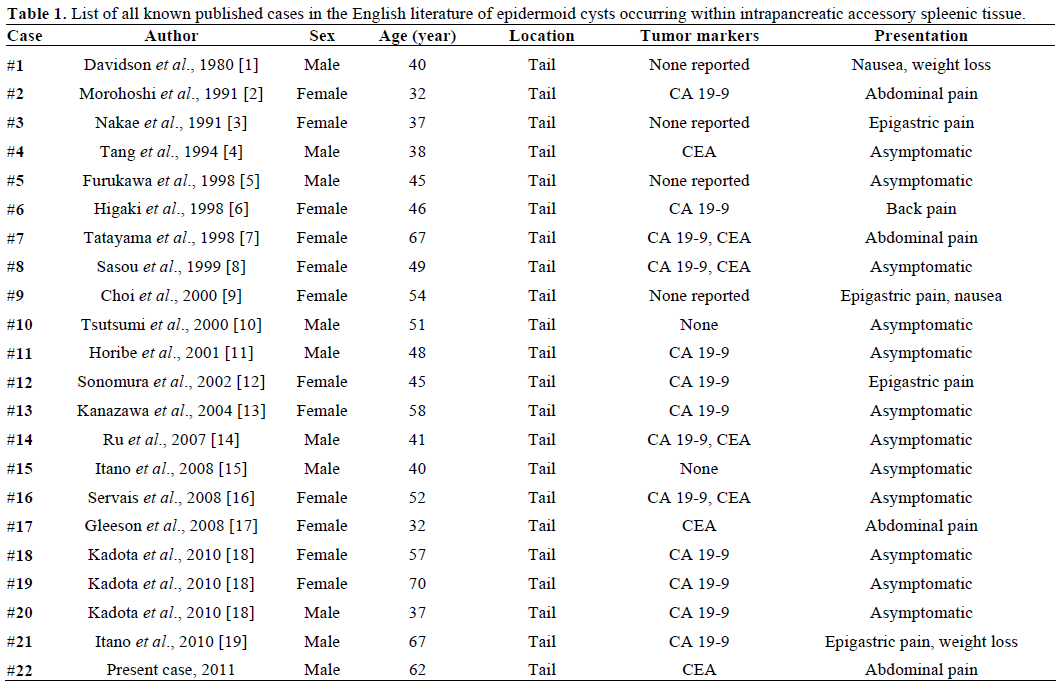- (2011) Volume 12, Issue 3
Adam J Horn, Subodh M Lele
Department of Pathology and Microbiology, University of Nebraska Medical Center. Omaha, NE, USA
Received March 11th, 2011 - Accepted April 4th, 2011
Context Epidermoid cysts occurring within intrapancreatic accessory spleens are exceptionally rare entities, with only 21 previously reported cases. Their clinical presentation prior to pathologic assessment can raise concern for possible malignancy; however, they behave in a benign fashion. Case report A 62-year-old male presented with complaints of abdominal pain. Imaging revealed leftsided retroperitoneal mass and surgical exploration was recommended. Surgery revealed a cystic cavity containing necrotic debris originating from the tail of the pancreas. Microscopy was consistent with an epidermoid cyst arising within an intrapancreatic accessory spleen with positive immunoperoxidase staining for CEA. Conclusion Epidermoid cysts occurring within intrapancreatic accessory spleens can mimic a malignant process both clinically and radiographically. Surgery with pathologic assessment is the only reliable means of diagnosis. While they are a very rare entity, it is an important component of a complete differential diagnosis for a patient presenting with a pancreatic tail mass.
Epidermal Cyst; Pancreas; Spleen
An epidermoid cyst occurring within an intrapancreatic accessory spleen is an extremely rare occurrence, with only 21 cases being described in the English literature since being first described in 1980 [1, 2, 3, 4, 5, 6, 7, 8, 9, 10, 11, 12, 13, 14, 15, 16, 17, 18, 19]. As these lesions are often detected incidentally on imaging and are occasionally associated with increased serum CA 19-9 and CEA levels, their discovery can raise concern of a cystic pancreatic neoplasm [6, 7, 8, 11, 12, 13, 18, 20, 21]. In this report we describe an epidermoid cyst arising within an intrapancreatic accessory spleen in a symptomatic individual which prompted surgical exploration.
The patient is a 62-year-old male who presented to a rural clinic with complains of vague left-sided abdominal pain. A Computed tomography (CT) scan was obtained which showed a left-sided retroperitoneal mass with a possible cystic component (Figure 1). Resection of the mass was advised and the patient was transferred to our tertiary academic medical center. Abdominal surgical exploration revealed a large mass containing a cystic cavity (4.8x3.7x1.9 cm in aggregate) consisting of hemorrhagic fatty soft tissue and purulent appearing debris originating from the tail of the pancreas. The cyst was removed and sent for pathologic examination. Microscopy revealed multiple epidermoid cysts within accessory splenic tissue (Figure 2). The cysts were lined by stratified squamous epithelium, some of which was keratinizing, and were variable in size. Several cysts appeared to have ruptured and had surrounding fat necrosis and foreign body giant cells. The lining of the cysts was positive for CEA on immunohistochemistry. The findings are consistent with a benign epidermoid cyst arising within accessory splenic tissue in the tail of the pancreas. The patient recovered without complication.
Epidermoid cysts of the spleen are a relatively infrequent cause of true non-parasitic splenic cysts. Accessory splenic tissue is a not uncommon finding at autopsy, with approximately 20% of accessory spleens occurring in the region of the tail of the pancreas [22]. However, epidermoid cysts occurring within an intrapancreatic accessory spleen are exceedingly rare, with only 21 previously reported cases (Table 1).

An epidermoid cyst histologically is comprised of a cystic space lined by keratinizing and non-keratinizing, non-hear bearing stratified squamous or cuboidal epithelium. All known cases arising in accessory splenic tissue have occurred within the tail of the pancreas, with sizes ranging from 1.5 to 11.5 cm, and have been reported to be both unilocular and multilocular [18]. It has been hypothesized that the cysts may arise due to a mesothelial inclusion that undergoes squamous metaplasia [23], as a byproduct of a teratoma [24], or as a communication between the pancreatic duct system with the intrapancreatic accessory spleen [7]. A recent report citing possible pancreatic duct material within an epidermoid cyst is supportive of the third theory [18]. Epidermoid cysts within an intrapancreatic accessory spleen have been associated with increases in serum CA 19-9 and CEA. Our case demonstrated immunoperoxidase positivity for CEA; no preoperative serum CEA or CA 19-9 levels were performed. D2-40 (a marker of epithelial origin) immunoperoxidase positivity has also recently been described [18].
The differential diagnosis includes pseudocysts, intraductal papillary mucinous neoplasms (IPMN), serous and mucinous cystadenomas, and lymphoepithelial cysts. A fine needle aspiration (FNA) of an epidermoid cyst within an intrapancreatic accessory spleen can yield pancreatic tissue, inflammatory debris, and fluid with increased CEA and CA 19-9 levels. These findings can be suggestive of malignancy; however, the presence of mature squamous epithelium and the lack of cytologically malignant appearing cells can be helpful in narrowing the differential diagnosis. There are no characteristic features to define the lesion on radiology, which when discovered can cause concern for a cystic pancreatic neoplasm as the radiographic findings can be quite similar [20]. There has been suggestion that the spleen and an intrapancreatic accessory spleen should demonstrate similar enhancement with contrast-enhanced CT imaging or MRI after superparamagnetic iron oxide administration [12, 21]. Because it is impossible to entirely rule out cystic pancreatic malignancies, surgical resection and histopathological examination is required for definitive diagnosis. Laparoscopic resection of an epidermoid cyst within an intrapancreatic accessory spleen has recently been described and offers the benefits of diminished pain and recovery time versus an open procedure in cases where the differential diagnosis favors a benign process but malignancy can not be ruled out [19].
In summary, an epidermoid cyst arising in intrapancreatic accessory spleen is a rare entity that can mimic malignant conditions. Because there is no reliable preoperative method to identify this entity, it remains a rare but important component in the differential diagnosis of cystic lesions in the tail of the pancreas.
The author has no potential conflicts of interest